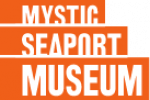 Annual maintenance of Treworgy Planetarium’s projector takes place every winter
Annual maintenance of Treworgy Planetarium’s projector takes place every winter
Every few thousand miles you bring your car into the shop for a tune up. Every thousand or so hours, Mystic Seaport does the same with its Treworgy Planetarium projector. Except in the case of the Spitz A3P optical mechanical projector, the “mechanic” comes to the Museum.
John Hare, founder of Ash Enterprises, spends his career traveling the globe performing maintenance and upkeep on planetarium equipment. He estimates there are 3,000 to 4,000 planetariums in the world, and about 1,500 in the United States. Hare has been working on the Museum’s projector for eight years, visiting annually for a few days every winter to completely clean and realign the equipment.
Hare founded Ash in 1971 after he realized while working for the Michigan State University planetarium that there was a market for projector maintenance. He started his planetarium career after serving in the U.S. Navy running sonar on a destroyer escort. Discharged in 1963, he took a job with Spitz Inc., the company that manufactures many of the world’s planetarium’s projectors. After a couple of years there he moved over to work for Michigan State, and went back to college to earn a degree in telecommunications. After 10 years, he decided to go out on his own. Today, Ash has five employees and 150 regular clients, including Mystic Seaport.
The Museum’s projector is a workhorse, notes Brian J. Koehler, supervisor of the Treworgy Planetarium. “We estimate the projector works about a thousand hours a year,” Koehler says. “In the summer, we do four shows a day, seven days a week. In the winter, we do seven shows a week and have school groups on our other days.”
The projector at Treworgy Planetarium is an Optical Mechanical Projector, made by Spitz Inc., Hare’s old employer. It is an older style of planetarium projector. The newer projectors are digital, which use video. The Museum’s projector uses a Star Ball to produce the star field visitors see in the dome over their heads. The Star Ball has a xenon arc lamp inside it, which illuminates the dome through the Star Ball. The ball has more than a thousand pinprick-sized holes in it, and the xenon arc lamp pushes light through those holes to make the stars above. This type of lamp is used for brilliance and for its compact size, Hare notes. He replaced it on this visit because it had been in for two years, and as it wears out, the stars “get fuzzy.”
This type of projector “renders the real sky” for visitors, Hare explains. Digital projectors project video onto the dome. “This is a much higher resolution than a digital projector,” Hare says. “This is more realistic and accurate. The drawback is with this type, we can only represent the sky as we see it from Earth. With a digital system, you can show perspectives from anywhere. It makes sense for the Seaport to have this type, since it engages in celestial navigation education and how the stars relate to maritime endeavors. It’s old, but it’s far from obsolete. It could last another 50 years.”
Koehler says this projector was installed in 2009. “It was a conscious decision to keep with the mechanical projector,” he says, “because in our opinion, the digital projection of the sky is not accurate enough. We believe this creates a more authentic night sky. We don’t want you to feel like you are looking at a movie – we want you to feel like you are looking at the stars.”
The authentic experience is important because Mystic Seaport is a maritime history museum that offers numerous celestial navigation classes, Koehler says, as well as astronomy outreach programs to many area schools and colleges, in addition to its regular planetarium shows offered to the general public.
Hare spends his time in the planetarium carefully dismantling the projector, cleaning every ring, gear, slip and part, and then reassembling it. After that, he meticulously realigns it so that all the stars and planets and the Sun are in the correct location, for all times of day and night. He makes sure everything is properly focused and uniformly illuminated. When he’s done, “you can definitely see a difference,” Koehler says. “The stars are sharp and bright.”

